Evaluation of the Effects of Nitrogen, Phosphorus, and Potassium Applications on the Growth, Yield, and Quality of Lettuce (Lactuca sativa L.)
Abstract
1. Introduction
2. Materials and Method
2.1. Plant Materials and Experimental Design
2.2. Measurements of Agronomic and Yield Parameters
2.3. Lettuce Quality Evaluations
2.4. Nutrient Concentration Analysis
2.5. Statistical Analysis
3. Results
3.1. Effects of Different N, P, and K Application Rates on Lettuce Growth
3.2. Effects of Different Nutrient Application Rates on Yield and Quality of Lettuce
3.3. The Functional Models of Fertilizing Effect between Nutrient Application and the Yield and Quality of Lettuce
3.4. Effect of N, P, and K Balanced Fertilization on Growth and Yield of Lettuce
3.5. Accumulation and Distribution of Dry Matter and Nutrients in Lettuce after Transplanting
4. Discussion
5. Conclusions
Author Contributions
Funding
Institutional Review Board Statement
Informed Consent Statement
Data Availability Statement
Conflicts of Interest
References
- Shi, M.; Gu, J.; Wu, H.; Rauf, A.; Emran, T.B.; Khan, Z.; Mitra, S.; Aljohani, A.S.M.; Alhumaydhi, F.A.; Al-Awthan, Y.S.; et al. Phytochemicals, nutrition, metabolism, bioavailability, and health benefits in lettuce-A comprehensive review. Antioxidants 2022, 11, 1158. [Google Scholar] [CrossRef] [PubMed]
- Sanchez, C.A.; El-Hout, N.M. Response of diverse lettuce types to fertiliser phosphorus. HortScience 1995, 30, 528–531. [Google Scholar] [CrossRef]
- Thapa, U.; Nandi, S.; Rai, R.; Upadhyay, A. Effect of nitrogen levels and harvest timing on growth, yield and quality of lettuce under floating hydroponic system. J. Plant Nutr. 2022, 45, 2563–2577. [Google Scholar] [CrossRef]
- Zandvakili, O.R.; Barker, A.V.; Hashemi, M.; Autio, W.R.; Etemadi, F.; Sadeghpour, A. Influence of nitrogen source and rate on lettuce yield and quality. Agron. J. 2022, 114, 1401–1414. [Google Scholar] [CrossRef]
- Křístková, E.; Doležalová, I.; Lebeda, A.; Vinter, V.; Novotná, A. Description of morphological characters of lettuce (Lactuca sativa L.) genetic resources. Hort. Sci. 2008, 35, 113–129. [Google Scholar] [CrossRef]
- Mou, B. Nutrient content of lettuce and its improvement. Curr. Nutr. Food Sci. 2009, 5, 242–248. [Google Scholar] [CrossRef]
- Kim, M.J.; Moon, Y.; Tou, J.C.; Mou, B.; Waterland, N.L. Nutritional value, bioactive compounds and health benefits of lettuce (Lactuca sativa L.). J. Food Compos. Anal. 2016, 49, 19–34. [Google Scholar] [CrossRef]
- Medina-Lozano, I.; Bertolín, J.R.; Díaz, A. Nutritional value of commercial and traditional lettuce (Lactuca sativa L.) and wild relatives: Vitamin C and anthocyanin content. Food Chem. 2021, 359, 129864. [Google Scholar] [CrossRef]
- Yang, X.; Gil, M.I.; Yang, Q.; Tomás-Barberán, F.A. Bioactive compounds in lettuce: Highlighting the benefits to human health and impacts of preharvest and postharvest practices. Compr. Rev. Food Sci. Food Saf. 2022, 21, 4–45. [Google Scholar] [CrossRef]
- Kreutz, G.F.; Bhadha, J.H.; Sandoya, G.V. Examining phosphorus use efficiency across different lettuce (Lactuca sativa L.) accessions. Euphytica 2022, 218, 28. [Google Scholar] [CrossRef]
- Cakmak, I. Plant nutrition research: Priorities to meet human needs for food in sustainable ways. Plant Soil. 2002, 247, 3–24. [Google Scholar] [CrossRef]
- Guo, J.H.; Liu, X.J.; Zhang, Y.; Shen, J.L.; Han, W.X.; Zhang, W.F.; Christie, P.; Goulding, K.W.; Vitousek, P.M.; Zhang, F.S. Significant acidification in major Chinese croplands. Science 2010, 327, 1008–1010. [Google Scholar] [CrossRef] [PubMed]
- Lal, R. Restoring soil quality to mitigate soil degradation. Sustainability 2015, 7, 5875–5895. [Google Scholar] [CrossRef]
- Mueller, N.D.; Gerber, J.S.; Johnston, M.; Ray, D.K.; Ramankutty, N.; Foley, J.A. Closing yield gaps through nutrient and water management. Nature 2012, 490, 254–257. [Google Scholar] [CrossRef] [PubMed]
- Chen, X.; Cui, Z.; Fan, M.; Vitousek, P.; Zhao, M.; Ma, W.; Wang, Z.; Zhang, W.; Yan, X.; Yang, J.; et al. Producing more grain with lower environmental costs. Nature 2014, 514, 486–489. [Google Scholar] [CrossRef] [PubMed]
- Hochmuth, G.J. Progress in mineral nutrition and nutrient management for vegetable crops in the last 25 years. Hortscience 2003, 38, 999–1003. [Google Scholar] [CrossRef]
- Liu, Z.H.; Jiang, L.H.; Li, X.L.; Hardter, R.; Zhang, W.J.; Zhang, Y.L.; Zhang, D.F. Effect of N and K fertilizers on yield and quality of greenhouse vegetable crops. Pedosphere 2008, 18, 496–502. [Google Scholar] [CrossRef]
- Wang, Z.H.; Li, S.; Malhi, S. Effects of fertilization and other agronomic measures on nutritional quality of crops. J. Sci. Food Agric. 2008, 88, 7–23. [Google Scholar] [CrossRef]
- Xu, Y.; Liu, Z.H.; Gao, X.H.; Li, G.S.; Shi, J.; Wei, J.L.; Tan, D.S.; Wang, M.; Jiang, L.H. Effects of nitrogen levels on yield, quality and soil environment of Chinese cabbage in open field. Acta Hortic. 2018, 1192, 169–178. [Google Scholar] [CrossRef]
- Hasnain, M.; Chen, J.; Ahmed, N.; Memon, S.; Wang, L.; Wang, Y.; Wang, P. The effects of fertilizer type and application time on soil properties, plant traits, yield and quality of tomato. Sustainability 2020, 12, 9065. [Google Scholar] [CrossRef]
- Song, J.; Yang, J.; Jeong, B.R. Growth, quality, and nitrogen assimilation in response to high ammonium or nitrate supply in cabbage (Brassica campestris L.) and lettuce (Lactuca sativa L.). Agronomy 2021, 11, 2556. [Google Scholar] [CrossRef]
- White, P.J.; Brown, P.H. Plant nutrition for sustainable development and global health. Ann. Bot. 2010, 105, 1073–1080. [Google Scholar] [CrossRef] [PubMed]
- Fan, M.; Shen, J.; Yuan, L.; Jiang, R.; Chen, X.; Davies, W.J.; Zhang, F. Improving crop productivity and resource use efficiency to ensure food security and environmental quality in China. J. Exp. Bot. 2012, 63, 13–24. [Google Scholar] [CrossRef] [PubMed]
- Dimkpa, C.O.; Fugice, J.; Singh, U.; Lewis, T.D. Development of fertilizers for enhanced nitrogen use efficiency—Trends and perspectives. Sci. Total Environ. 2020, 731, 139113. [Google Scholar] [CrossRef]
- Conley, D.J.; Paerl, H.W.; Howarth, R.W.; Boesch, D.F.; Seitzinger, S.P.; Havens, K.E.; Lancelot, C.; Likens, G.E. Ecology. Controlling eutrophication: Nitrogen and phosphorus. Science 2009, 323, 1014–1015. [Google Scholar] [CrossRef]
- Albornoz, F. Crop responses to nitrogen overfertilization: A review. Sci. Hortic. 2016, 205, 79–83. [Google Scholar] [CrossRef]
- Hoque, M.M.; Ajwa, H.; Othman, M.; Smith, R.; Cahn, M. Yield and postharvest quality of lettuce in response to nitrogen, phosphorus, and potassium fertilizers. HortScience 2010, 45, 1539–1544. [Google Scholar] [CrossRef]
- Jate, M. Long-term effect of balanced mineral fertilizer application on potato, winter rye, and oat yields; nutrient use efficiency; and soil fertility. Arch. Agron. Soil Sci. 2010, 56, 421–432. [Google Scholar] [CrossRef]
- Zhang, L.; Su, W.; Tao, R.; Zhang, W.; Chen, J.; Wu, P.C.; Yan, Y.; Jia, R.; Larkin, D.; Lavelle, M.J.; et al. RNA sequencing provides insights into the evolution of lettuce and the regulation of flavonoid biosynthesis. Nat. Commun. 2017, 8, 2264. [Google Scholar] [CrossRef]
- Coria-Cayupán, Y.S.; Sánchez de Pinto, M.a.I.; Nazareno, M.n.A. Variations in bioactive substance contents and crop yields of lettuce (Lactuca sativa L.) cultivated in soils with different fertilization treatments. J. Agric. Food Chem. 2009, 57, 10122–10129. [Google Scholar] [CrossRef]
- Inkham, C.; Panjama, K.; Seehanam, P.; Ruamrungsri, S. Effect of nitrogen, potassium and calcium concentrations on growth, yield and nutritional quality of green oak lettuce. Acta Hortic. 2021, 1312, 409–416. [Google Scholar] [CrossRef]
- Albornoz, F.; Heinrich Lieth, J. Over fertilization limits lettuce productivity because of osmotic stress. Chil. J. Agr. Res. 2015, 75, 284–290. [Google Scholar] [CrossRef]
- Jin, N.; Jin, L.; Wang, S.; Li, J.; Liu, F.; Liu, Z.; Luo, S.; Wu, Y.; Lyu, J.; Yu, J. Reduced chemical fertilizer combined with bio-organic fertilizer affects the soil microbial community and yield and quality of lettuce. Front. Microbiol. 2022, 13, 863325. [Google Scholar] [CrossRef] [PubMed]
- Arya, S.; Mahajan, M.; Jain, P. Non-spectrophotometric methods for the determination of Vitamin C. Anal. Chim. Acta 2000, 417, 1–14. [Google Scholar] [CrossRef]
- Li, H.; Sun, Q.; Zhao, S.; Zhang, W. Principles and Techniques of Plant Physiological Biochemical Experiment; Higher Education Press: Beijing, China, 2000; pp. 195–197. [Google Scholar]
- Sedmak, J.J.; Grossberg, S.E. A rapid, sensitive, and versatile assay for protein using Coomassie brilliant blue G250. Anal. Biochem. 1977, 79, 544–552. [Google Scholar] [CrossRef]
- Cataldo, D.; Maroon, M.; Schrader, L.; Youngs, V. Rapid colorimetric determination of nitrate in plant tissue by nitration of salicylic acid. Commun. Soil Sci. Plant Anal. 1975, 6, 71–80. [Google Scholar] [CrossRef]
- Lee, Y.P.; Takahashi, T. An improved colorimetric determination of amino acids with the use of ninhydrin. Anal. Biochem. 1966, 14, 71–77. [Google Scholar] [CrossRef]
- Thomas, R.L.; Sheard, R.W.; Moyer, J.R. Comparison of conventional and automated procedures for nitrogen, phosphorus, and potassium analysis of plant material using a single digestion. Agron. J. 1967, 59, 240–243. [Google Scholar] [CrossRef]
- Simko, L. Genetic variation in response to N, P, or K deprivation in baby leaf lettuce. Horticulturae 2020, 6, 15. [Google Scholar] [CrossRef]
- Bottoms, T.G.; Smith, R.F.; Cahn, M.D.; Hartz, T.K. Nitrogen requirements and N status determination of lettuce. HortScience 2012, 47, 1768–1774. [Google Scholar] [CrossRef]
- Bao, L. Significance of balanced fertilization based on long-term fertilizer experiments. Better. Crops Int. 1997, 11, 8–9. [Google Scholar]
- Roberts, T.L. Improving nutrient use efficiency. Turk. J. Agric. For. 2008, 32, 177–182. [Google Scholar]
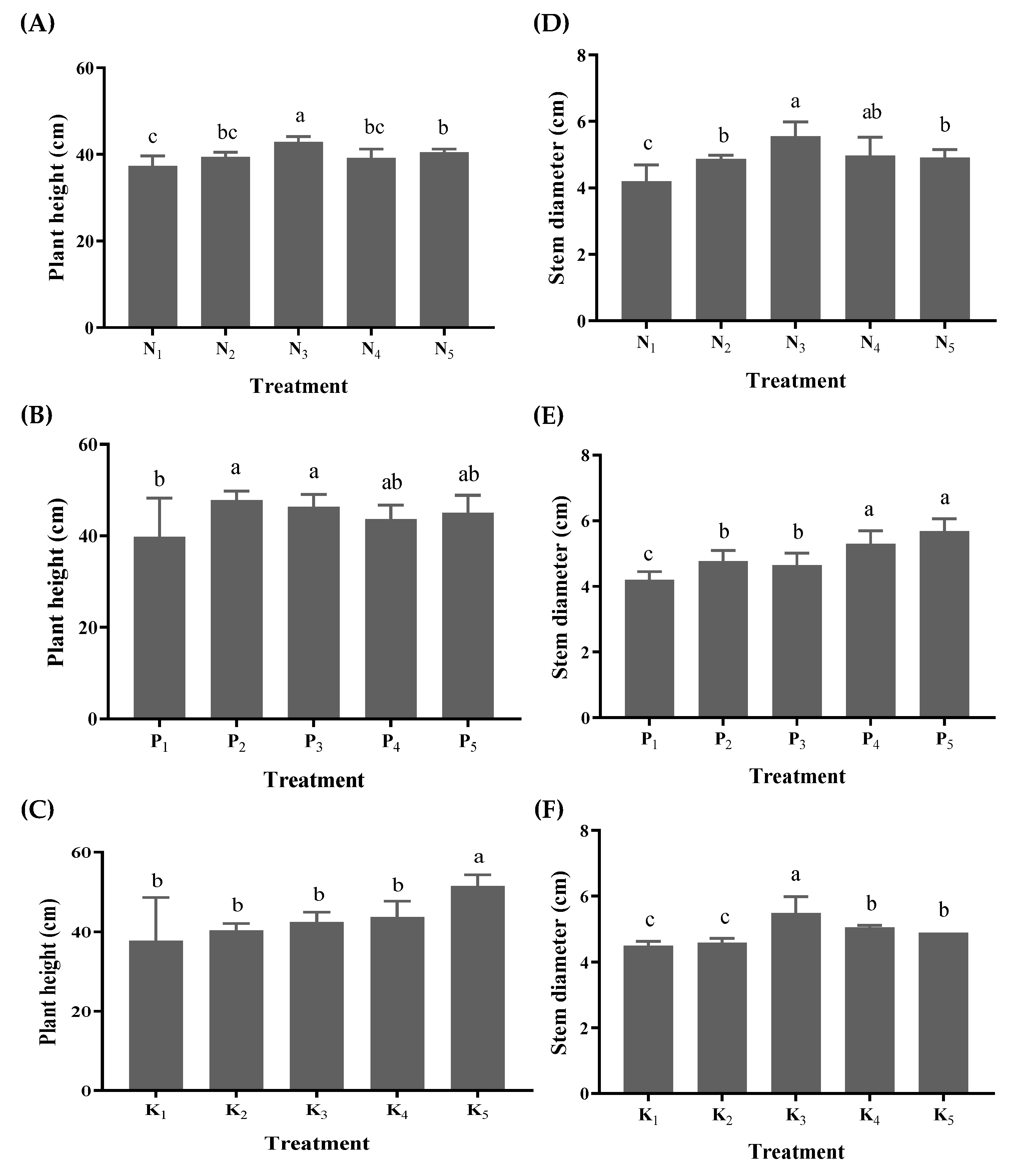

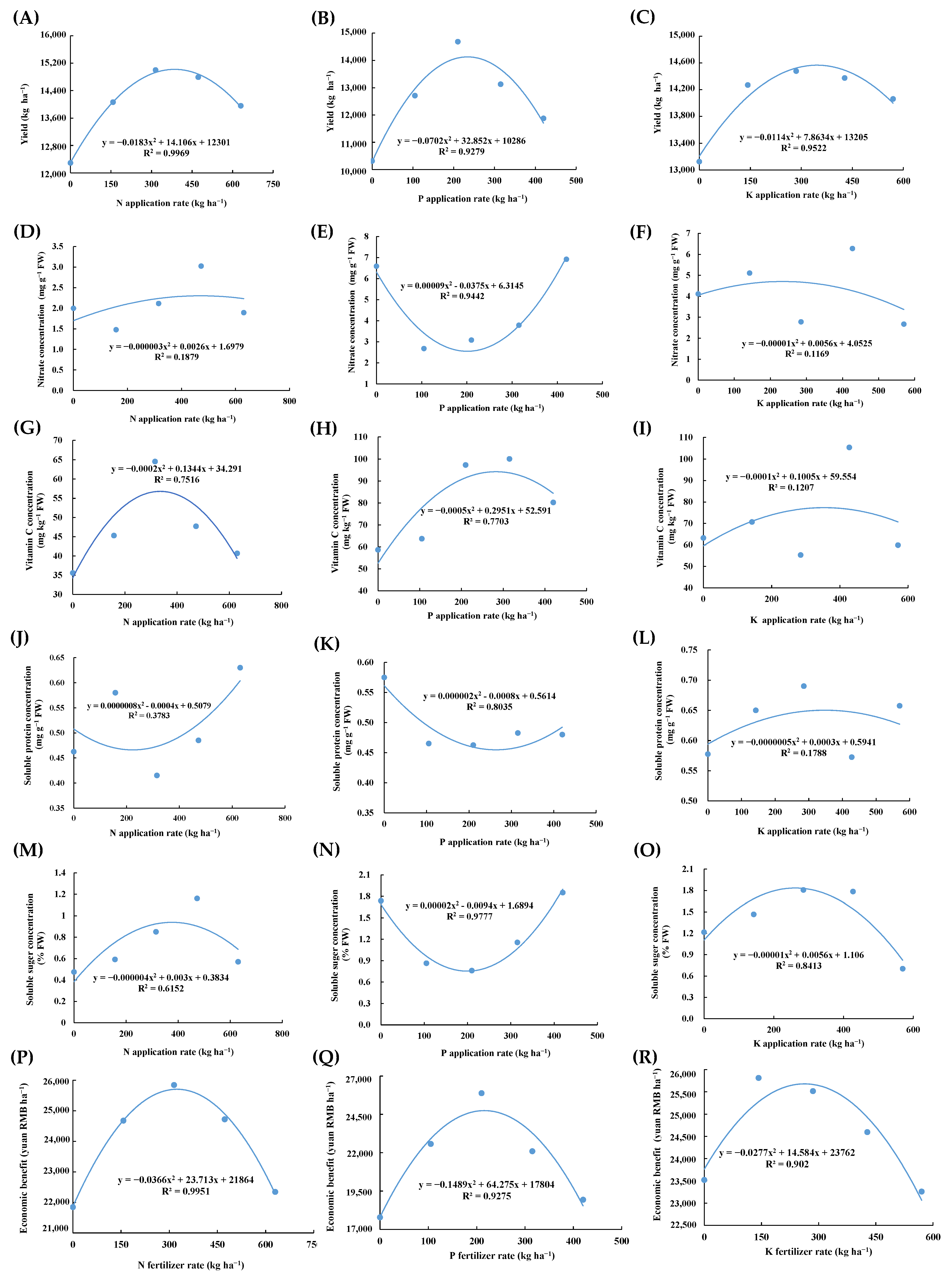
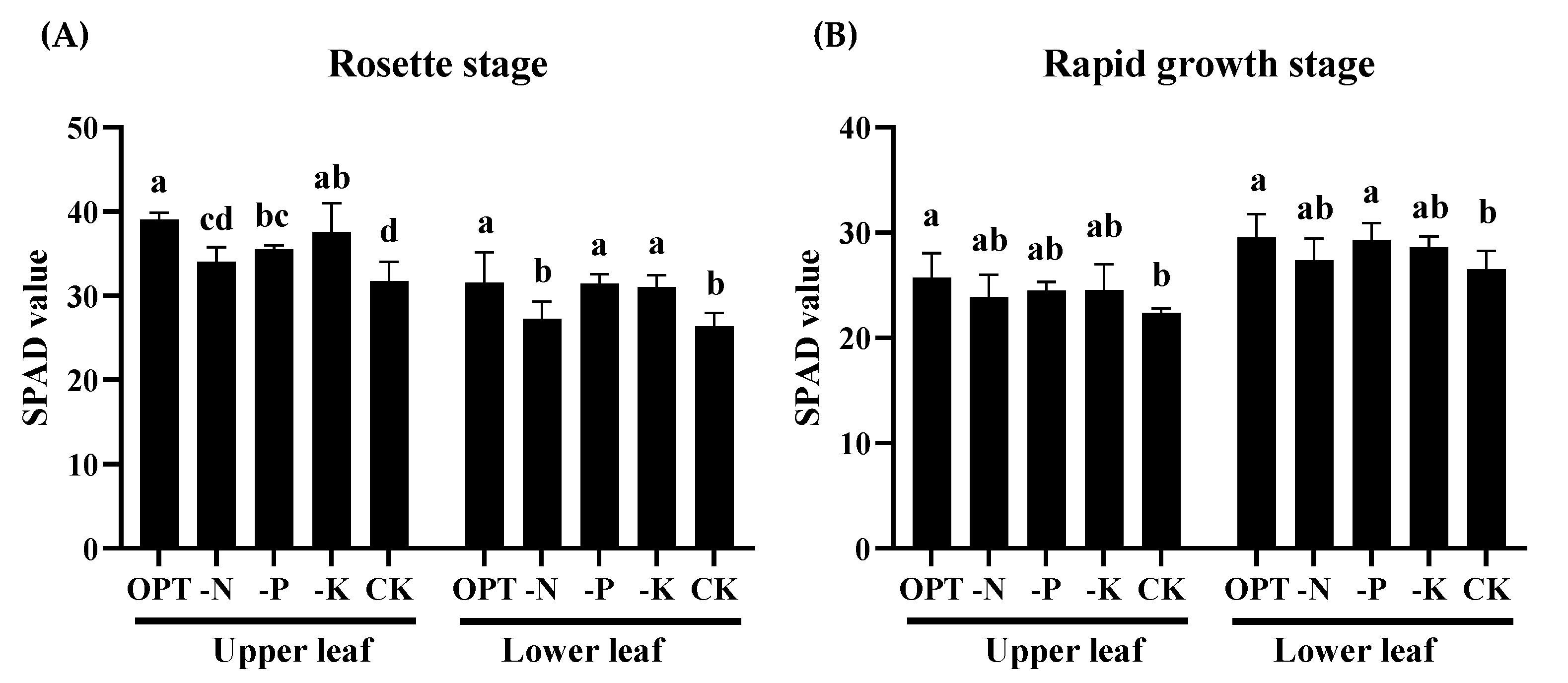
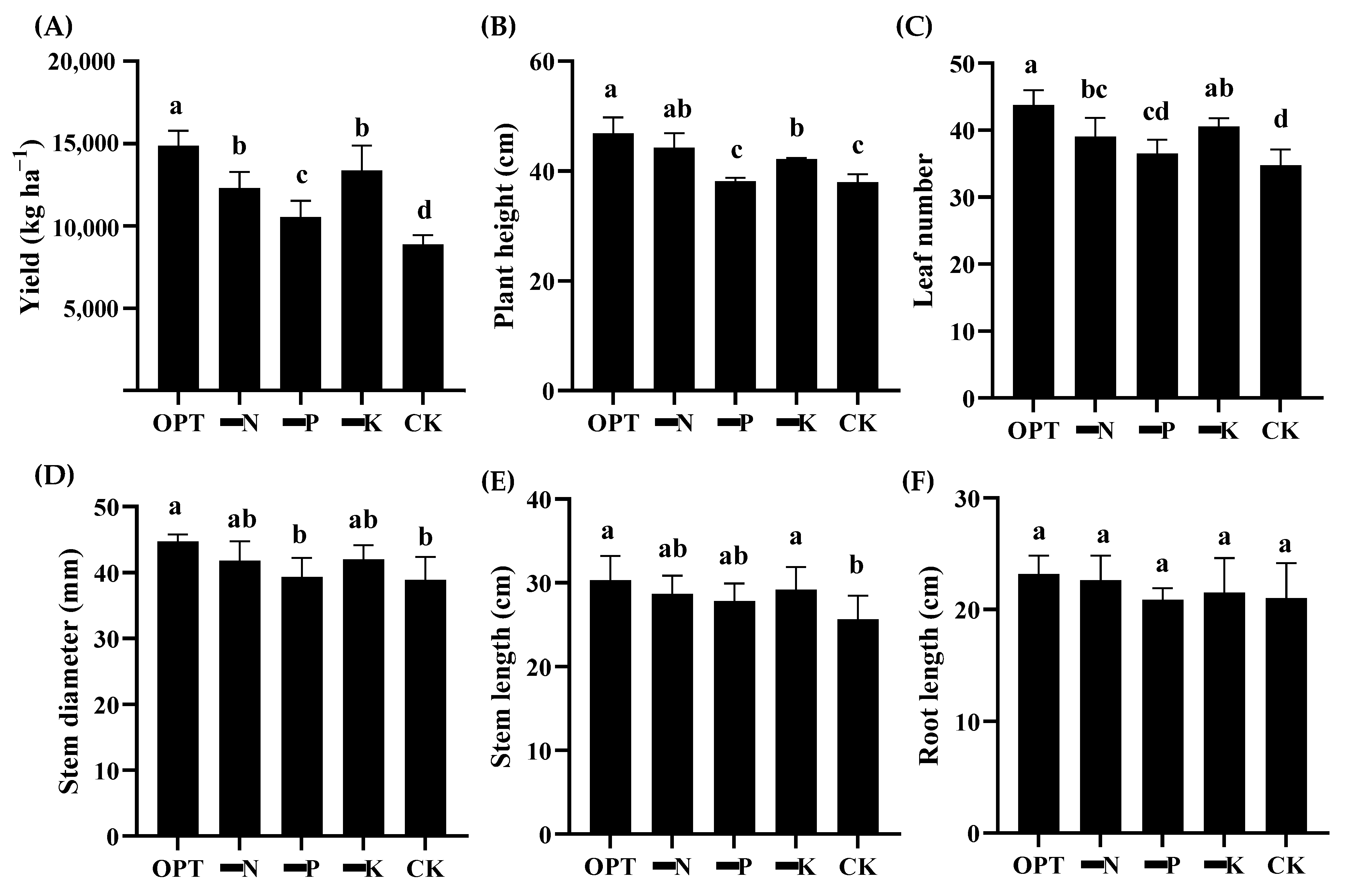
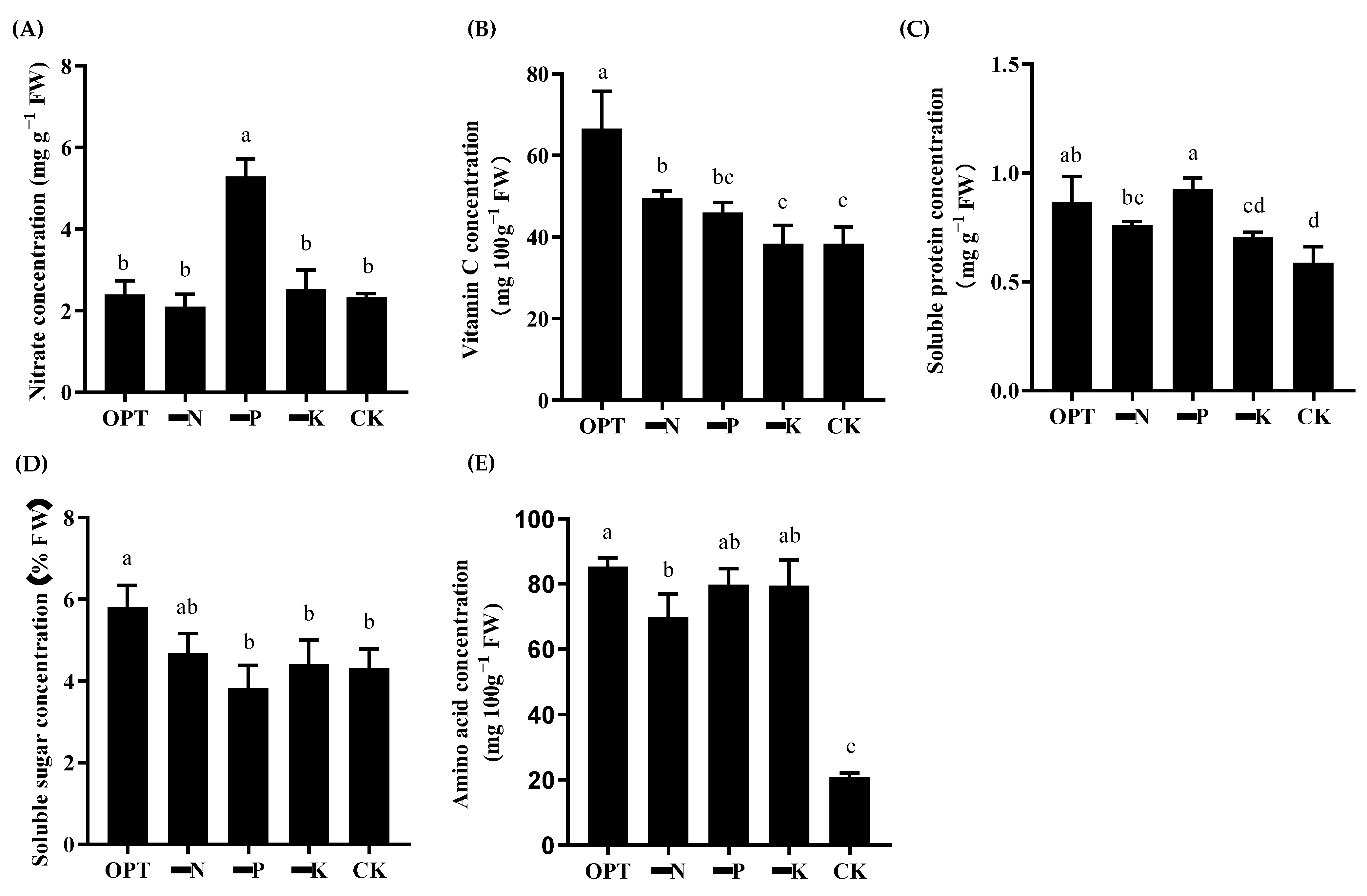
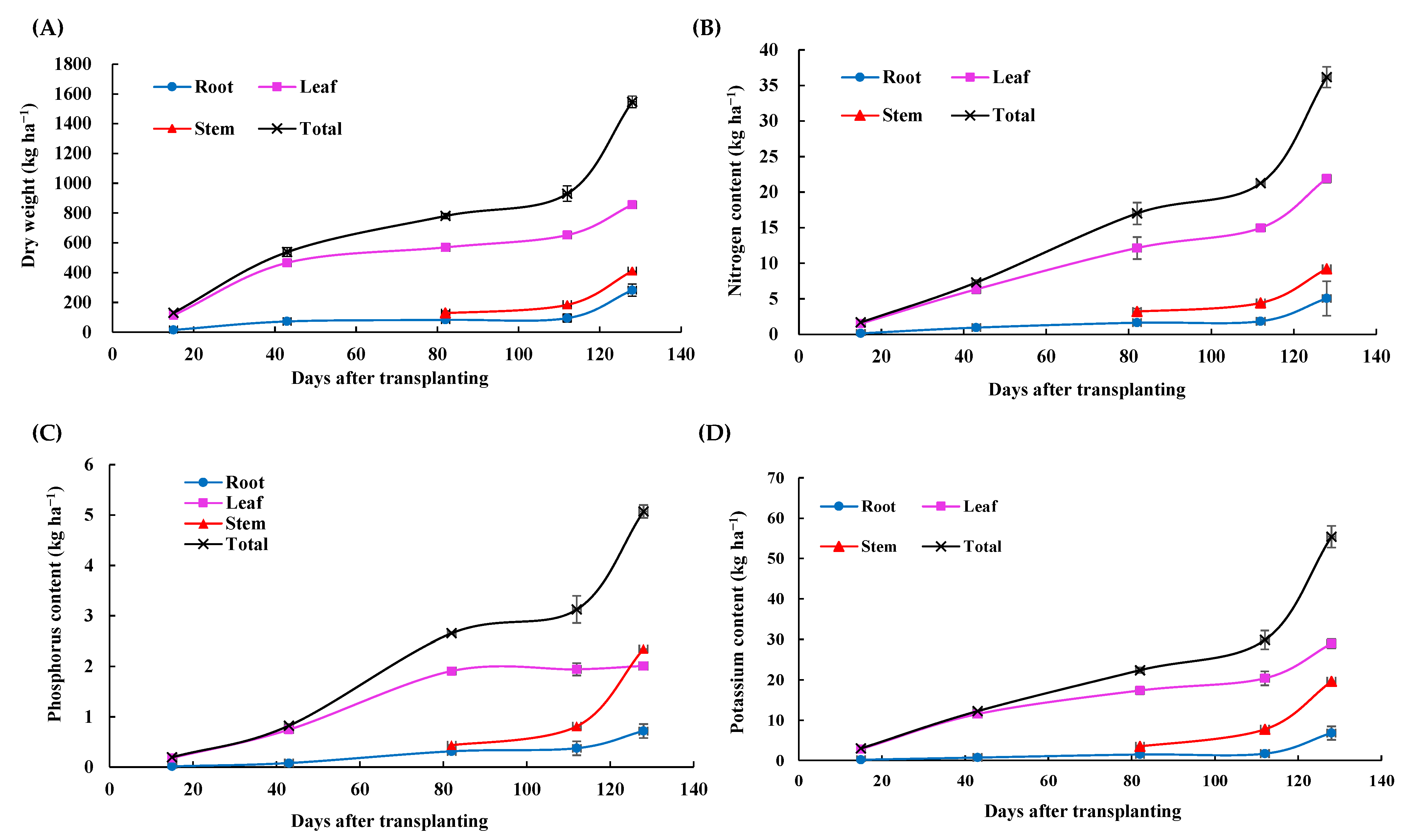
| Treatments | Fertilizer Application Amount (kg ha−1) | ||
|---|---|---|---|
| N | P2O5 | K2O | |
| N1 | 0 | 210 | 285 |
| N2 | 157.5 | 210 | 285 |
| N3 | 315.0 | 210 | 285 |
| N4 | 472.5 | 210 | 285 |
| N5 | 630.0 | 210 | 285 |
| P1 | 315 | 0 | 285 |
| P2 | 315 | 105 | 285 |
| P3 | 315 | 210 | 285 |
| P4 | 315 | 315 | 285 |
| P5 | 315 | 420 | 285 |
| K1 | 315 | 210 | 0 |
| K2 | 315 | 210 | 142.5 |
| K3 | 315 | 210 | 285.0 |
| K4 | 315 | 210 | 427.5 |
| K5 | 315 | 210 | 570.0 |
| Treatment | Yield (kg ha−1) | Increase Rate (%) | Nitrate Concentration (mg g−1 FW) | Vitamin C Concentration (mg kg−1 FW) | Soluble Protein Concentration (mg g−1 FW) | Soluble Sugar Concentration (% FW) |
|---|---|---|---|---|---|---|
| N1 | 12,292 ± 786 b | - | 1.48 ± 0.24 c | 35.58 ± 3.59 d | 0.46 ± 0.02 c | 0.48 ± 0.01 cd |
| N2 | 14,063 ± 312 ab | 14.40 | 2.00 ± 0.15 b | 45.30 ± 3.16 bc | 0.58 ± 0.04 b | 0.39 ± 0.07 d |
| N3 | 15,000 ± 120 a | 22.03 | 2.12 ± 0.24 b | 64.58 ± 2.59 a | 0.42 ± 0.04 d | 0.85 ± 0.10 b |
| N4 | 14,792 ± 1183 ab | 20.34 | 3.03 ± 0.07 a | 47.73 ± 3.22 b | 0.49 ± 0.01 c | 1.16 ± 0.11 a |
| N5 | 13,959 ± 2345 c | 13.56 | 1.89 ± 0.15 b | 40.68 ± 4.27 cd | 0.63 ± 0.03 a | 0.57 ± 0.04 c |
| Treatment | Yield (kg ha−1) | Increase Rate (%) | Nitrate Concentration (mg g−1 FW) | Vitamin C Concentration (mg kg−1 FW) | Soluble Protein Concentration (mg g−1 FW) | Soluble Sugar Concentration (% FW) |
|---|---|---|---|---|---|---|
| P1 | 10,312 ± 920 c | - | 6.59 ± 1.09 a | 58.68 ± 13.67 c | 0.58 ± 0.13 a | 1.74 ± 0.27 a |
| P2 | 12,708 ± 70 b | 23.23 | 2.68 ± 0.16 b | 63.73 ± 9.15 c | 0.47 ± 0.05 a | 0.87 ± 0.13 c |
| P3 | 14,688 ± 884 a | 42.42 | 3.09 ± 0.82 b | 97.33 ± 0.96 a | 0.46 ± 0.02 a | 0.76 ± 0.09 c |
| P4 | 13,125 ± 92 b | 27.27 | 3.79 ± 0.41 b | 100.13 ±5.15 a | 0.48 ± 0.03 a | 1.16 ± 0.11 b |
| P5 | 11,875 ± 1169 b | 15.15 | 6.92 ± 0.82 a | 80.28 ± 2.67 b | 0.48 ± 0.09 a | 1.85 ± 0.15 a |
| Treatment | Yield (kg ha−1) | Increase Rate (%) | Nitrate Concentration (mg g−1 FW) | Vitamin C Concentration (mg kg−1 FW) | Soluble Protein Concentration (mg g−1 FW) | Soluble Sugar Concentration (% FW) |
|---|---|---|---|---|---|---|
| K1 | 13,125 ± 1275 c | - | 4.12 ± 0.73 c | 63.25 ±2.60 c | 0.58 ± 0.02 b | 1.22 ± 0.14 b |
| K2 | 14,271 ± 1178 a | 8.73 | 5.11 ± 0.27 b | 70.73 ± 3.23 bc | 0.65 ± 0.04 a | 1.47 ± 0.38 b |
| K3 | 14,479 ± 1160 a | 10.32 | 2.79 ± 0.48 d | 85.34 ± 10.01 b | 0.69 ± 0.05 a | 1.81 ± 0.10 a |
| K4 | 14,375 ± 765 a | 9.52 | 6.28 ± 0.31 a | 105.33 ± 17.88 a | 0.57 ± 0.06 b | 1.79 ± 0.20 a |
| K5 | 14,062 ± 1276 a | 7.14 | 2.68 ± 0.30 d | 59.88 ± 2.33 c | 0.66 ± 0.05 a | 0.70 ± 0.05 c |
Publisher’s Note: MDPI stays neutral with regard to jurisdictional claims in published maps and institutional affiliations. |
© 2022 by the authors. Licensee MDPI, Basel, Switzerland. This article is an open access article distributed under the terms and conditions of the Creative Commons Attribution (CC BY) license (https://creativecommons.org/licenses/by/4.0/).
Share and Cite
Hong, J.; Xu, F.; Chen, G.; Huang, X.; Wang, S.; Du, L.; Ding, G. Evaluation of the Effects of Nitrogen, Phosphorus, and Potassium Applications on the Growth, Yield, and Quality of Lettuce (Lactuca sativa L.). Agronomy 2022, 12, 2477. https://doi.org/10.3390/agronomy12102477
Hong J, Xu F, Chen G, Huang X, Wang S, Du L, Ding G. Evaluation of the Effects of Nitrogen, Phosphorus, and Potassium Applications on the Growth, Yield, and Quality of Lettuce (Lactuca sativa L.). Agronomy. 2022; 12(10):2477. https://doi.org/10.3390/agronomy12102477
Chicago/Turabian StyleHong, Juan, Fangsen Xu, Gang Chen, Xiang Huang, Suping Wang, Lei Du, and Guangda Ding. 2022. "Evaluation of the Effects of Nitrogen, Phosphorus, and Potassium Applications on the Growth, Yield, and Quality of Lettuce (Lactuca sativa L.)" Agronomy 12, no. 10: 2477. https://doi.org/10.3390/agronomy12102477
APA StyleHong, J., Xu, F., Chen, G., Huang, X., Wang, S., Du, L., & Ding, G. (2022). Evaluation of the Effects of Nitrogen, Phosphorus, and Potassium Applications on the Growth, Yield, and Quality of Lettuce (Lactuca sativa L.). Agronomy, 12(10), 2477. https://doi.org/10.3390/agronomy12102477







